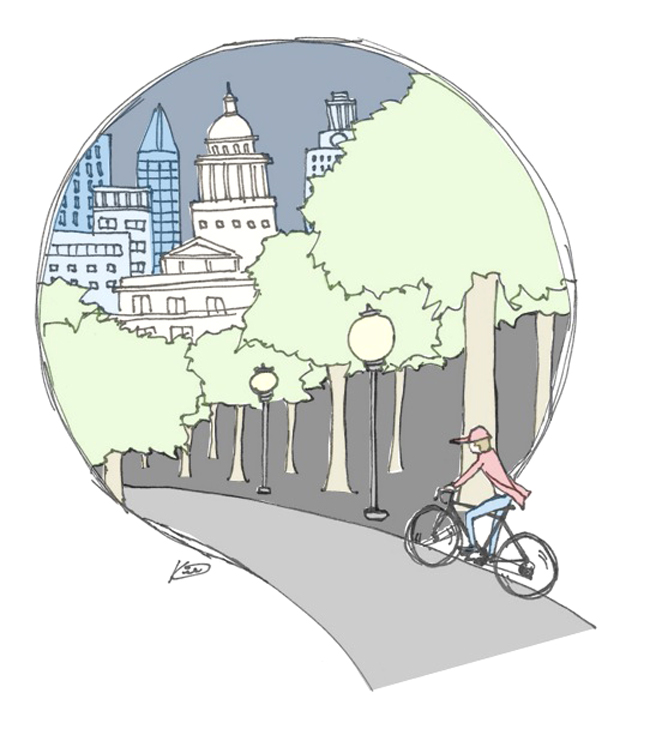It’s not hard to find evidence of the vast and thriving bike culture in Austin. One look at any campus bike rack and you’ll know — cycling is a pretty big thing around here. Hold your horses, though (or your bikes for that matter). Even if you’ve been riding your bike since the second grade (or if you’re like me and didn’t learn to ride until the sixth grade), riding in Austin will be a learning experience all over again.
First of all: Get a u-lock.
Lots of bikes means lots of bike theft, and unless you want a new $500 bike every semester, lock ‘er up. Chain locks are easier to clip open, but a u-lock around the frame and the front tire is a formidable contender. Now if you add a chain lock securing the rest of your bike, you’re as safe as can be.
Second lesson: Stay off of the sidewalks.
UT completely outlaws biking on the sidewalks, so unless you’re coming in from or about to merge into a road or unless you don’t care about those costly tickets, stick to the asphalt. A lot of bike “accidents” (an accident is something that cannot be prevented, and this can be) happen on the sidewalks, when a rider fails to maneuver around pedestrians or obstacles properly. The irony here is that most of us try to ride on the sidewalks for the sake of safety when clearly this sense of security is fabricated. Sidewalks are designed for slow foot traffic, not zippy cyclists. The city also forbids riding on the sidewalk, enforced especially around the downtown area. City tickets are usually pricier, too. Just saying.
Third: Use the road.
And I’m not talking about the Viggo Mortensen movie about apocalyptic times. I’m talking about that paved path on which cars zoom by. In Austin, bikes are vehicles, and therefore they have the same rights as any other vehicle on the road. By law, you must ride as far to the right as is “practicable” (or left if you’re on a one-way street). But here’s the kicker: you can take up the whole lane if it is less than 14 feet wide. Have you ever measured 14 feet? That’s a lot of feet. That’s around two Yao Mings lying perpendicular to the road, and some change. This also gives you room to maneuver in case of obstacles.
Plus, cars usually prefer that you take up a whole lane, too.
Imagine yourself in the driver’s seat. Sure, you have to slow down behind a biker and pass them using the adjoining lane, but what’s less nerve-racking: passing lanes or trying to share the same lane without hitting the biker? Take advantage of bike lanes, too, but you’re not required by law to ride in them. If there are any hazards on the bike lane (gravel, potholes) or if there are parked cars right next to it, you should merge onto the right lane of regular traffic as long as necessary. Don’t ride less than three feet away from parked cars, either. You could be surprised by a door opening.
Fourth: Make yourself visible.
In defensive cycling (yes, there is such a thing), predictability in your cycling and maximum visibility is stressed — and with good reason. If you’re turning or merging right, scan the road behind you for cars, hold your right arm out to your right side, scan again and make eye contact with the driver; once they yield, proceed with your action. For left, do the same with your left arm or point your right hand straight up. For slowing down, hold your arm abreast and your hand down so that the car behind you can see your whole palm. The law requires you to have a front light and either a red light or reflector on the rear that can be seen from at least 500 feet away. This makes riding at dusk and night much more comfortable.
Fifth: Follow traffic signs.
Since bicycles have the same rights as other vehicles, they also have to adhere to the same traffic laws. That translates into stopping at lights, signaling when needed, not riding in between cars and, among other things, making complete stops at stop signs — making yourself predictable to other drivers. No matter how slow a speed you brake into, or how steep the hill after the stop sign is, if you don’t stop at a stop sign you can get a painful traffic ticket. Beware!
Lastly, check your bike daily.
The best way to avoid an accident is to make sure that your cycle is in tip-top condition. Check the air on your tires, check your brakes and check your chain before every ride. Do maintenance as often as possible. It should become second nature. Note that helmets are not mandated by law if you’re 18 and over, but they are unbeatable protection in case of a collision.
Welcome to the bicyclub. Ride on.





















